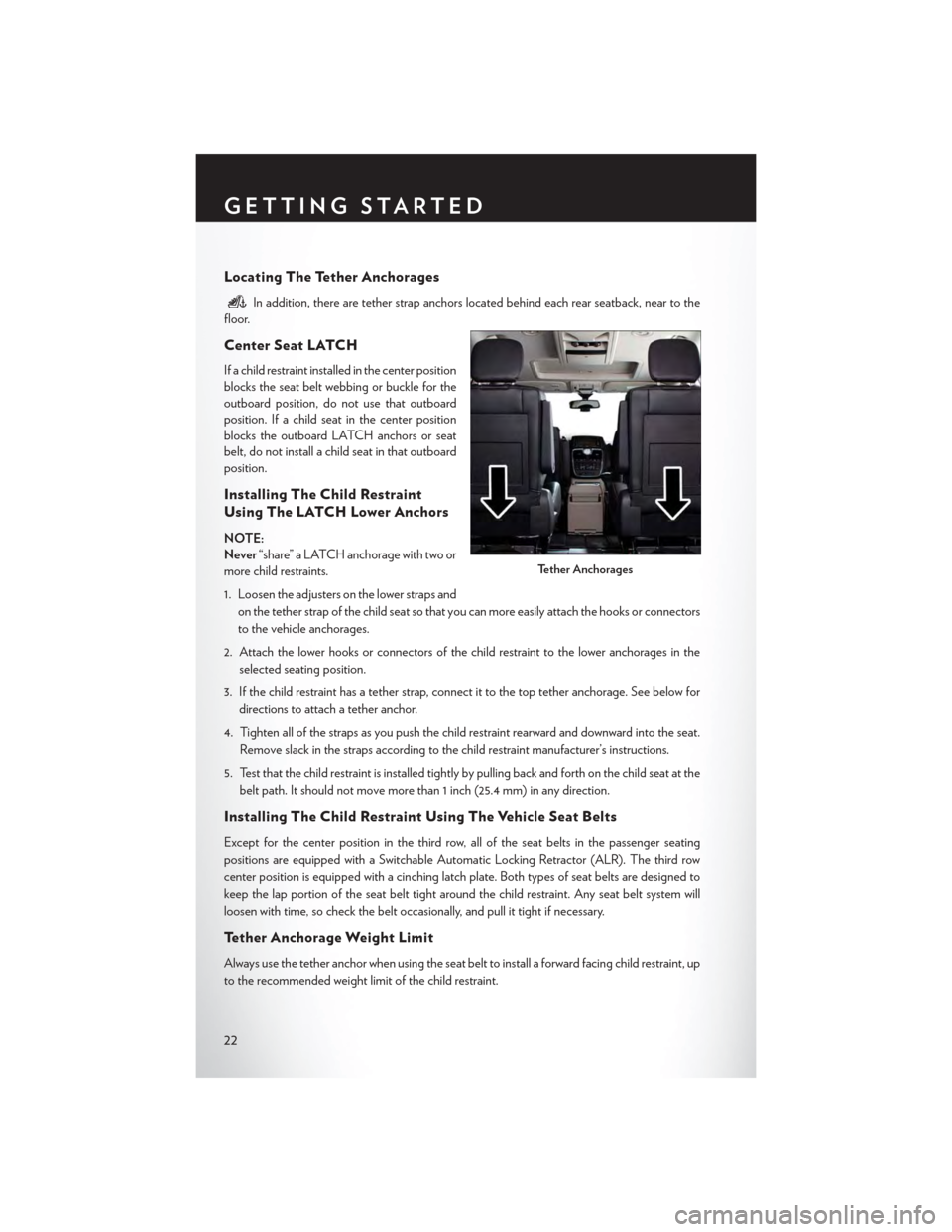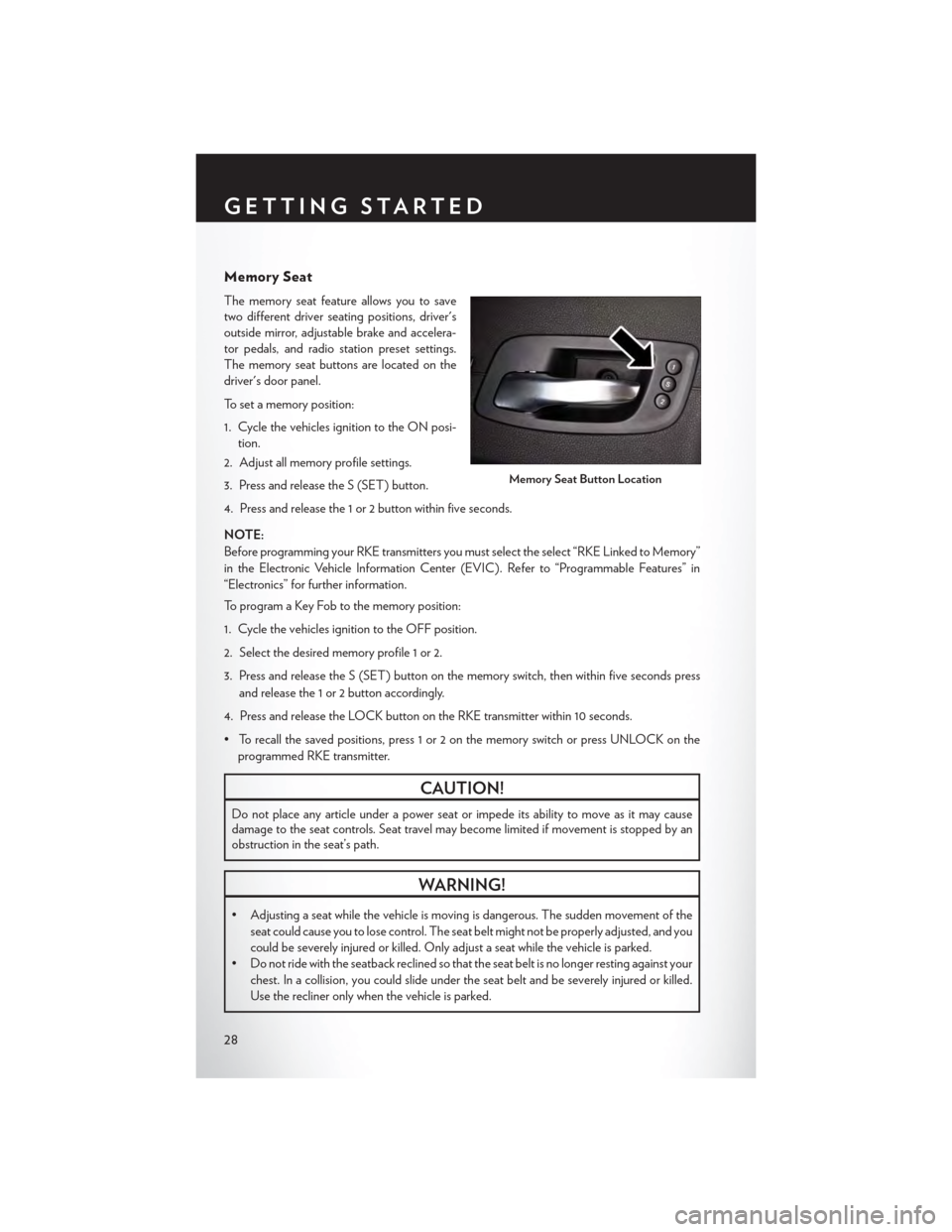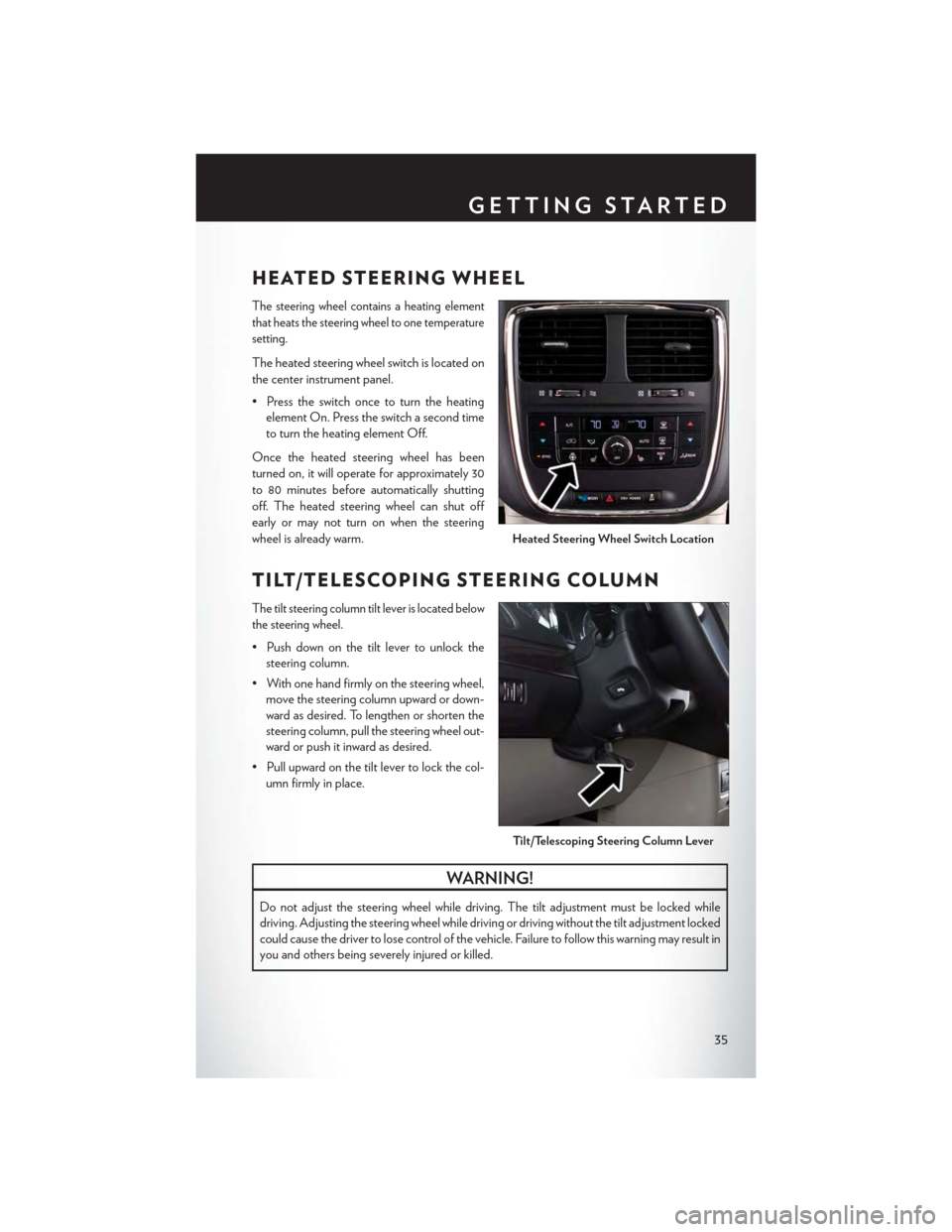lock CHRYSLER TOWN AND COUNTRY 2015 5.G Owner's Manual
[x] Cancel search | Manufacturer: CHRYSLER, Model Year: 2015, Model line: TOWN AND COUNTRY, Model: CHRYSLER TOWN AND COUNTRY 2015 5.GPages: 164, PDF Size: 22.47 MB
Page 22 of 164

Supplemental Side Air Bags
•ThisvehicleisequippedwithSupplementalSeat-MountedSideAirBags(SABs)locatedin
the outboard side of the front seats. The SABs are marked with a SRS AIRBAG or AIRBAG
label sewn into the outboard side of the seats.
•ThisvehicleisequippedwithSupplementalSideAirBagInflatableCurtains(SABICs)located
above the side windows. The trim covering the SABICs is labeled SRS AIRBAG or AIRBAG.
The SABICs may help reduce the risk of partial or complete ejection of vehicle occupants
through side windows in certain side impact events.
•TheSABICsandSABs(“SideAirBags”)aredesignedtoactivateincertainsideimpactsand
certain rollover events. The Occupant Restraint Controller (“ORC”) determines whether the
deployment of the Side Air Bags in a particular side impact or rollover event is appropriate,
based on the severity and type of collision. Vehicle damage by itself is not a good indicator of
whether or not Side Air Bags should have deployed.
WARNING!
• Side Air Bags need room to inflate. Do not lean against the door or window. Sit upright in
the center of the seat.
•BeingtooclosetotheSideAirBagsduringdeploymentcouldcauseyoutobeseverely
injured or killed.
•RelyingontheSideAirBagsalonecouldleadtomoresevereinjuriesinacollision.The
Side Air Bags work with your seat belt to restrain you properly. In some collisions, Side Air
Bags won’t deploy at all. Always wear your seat belt even though you have Side Air Bags.
•ThisvehicleisequippedwithleftandrightSupplementalSideAirBagInflatableCurtains
(SABICs). Do not stack luggage or other cargo up high enough to block the deployment
of the SABICs. The trim covering above the side windows where the SABIC and its
deployment path are located should remain free from any obstructions.
•ThisvehicleisequippedwithSABICs.InorderfortheSABICstoworkasintended,donot
install any accessory items in your vehicle which could alter the roof. Do not add an
aftermarket sunroof to your vehicle. Do not add roof racks that require permanent
attachments (bolts or screws) for installation on the vehicle roof. Do not drill into the roof
of the vehicle for any reason.
•DonotuseaccessoryseatcoversorplaceobjectsbetweenyouandtheSideAirBags;the
performance could be adversely affected and/or objects could be pushed into you,
causing serious injury.
GETTING STARTED
20
Page 24 of 164

Locating The Tether Anchorages
In addition, there are tether strap anchors located behind each rear seatback, near to the
floor.
Center Seat LATCH
If a child restraint installed in the center position
blocks the seat belt webbing or buckle for the
outboard position, do not use that outboard
position. If a child seat in the center position
blocks the outboard LATCH anchors or seat
belt, do not install a child seat in that outboard
position.
Installing The Child Restraint
Using The LATCH Lower Anchors
NOTE:
Never“share” a LATCH anchorage with two or
more child restraints.
1. Loosen the adjusters on the lower straps and
on the tether strap of the child seat so that you can more easily attach the hooks or connectors
to the vehicle anchorages.
2. Attach the lower hooks or connectors of the child restraint to the lower anchorages in the
selected seating position.
3. If the child restraint has a tether strap, connect it to the top tether anchorage. See below for
directions to attach a tether anchor.
4. Tighten all of the straps as you push the child restraint rearward and downward into the seat.
Remove slack in the straps according to the child restraint manufacturer’s instructions.
5. Test that the child restraint is installed tightly by pulling back and forth on the child seat at the
belt path. It should not move more than 1 inch (25.4 mm) in any direction.
Installing The Child Restraint Using The Vehicle Seat Belts
Except for the center position in the third row, all of the seat belts in the passenger seating
positions are equipped with a Switchable Automatic Locking Retractor (ALR). The third row
center position is equipped with a cinching latch plate. Both types of seat belts are designed to
keep the lap portion of the seat belt tight around the child restraint. Any seat belt system will
loosen with time, so check the belt occasionally, and pull it tight if necessary.
Te t h e r A n c h o r a g e W e i g h t L i m i t
Always use the tether anchor when using the seat belt to install a forward facing child restraint, up
to the recommended weight limit of the child restraint.
Tether Anchorages
GETTING STARTED
22
Page 25 of 164

To I n s t a l l A C h i l d S e a t U s i n g A n A L R :
1. Pull enough of the seat belt webbing from the retractor to pass it through the belt path of the
child restraint. Do not twist the belt webbing in the belt path.
2. Slide the latch plate into the buckle until you hear a “click.”
3. Pull on the webbing to make the lap portion tight against the child seat.
4. To lock the seat belt, pull down on the shoulder part of the belt until you have pulled all the seat
belt webbing out of the retractor. Then, allow the webbing to retract back into the retractor.
As the webbing retracts, you will hear a clicking sound. This means the seat belt is now in the
Automatic Locking mode.
5. Try to pull the webbing out of the retractor. If it is locked, you should not be able to pull out any
webbing. If the retractor is not locked, repeat the last step.
6. Finally, pull up on any extra webbing to tighten the lap portion around the child restraint while
you push the child restraint rearward and downward into the vehicle seat.
7. If the child restraint has a top tether strap and the seating position has a top tether anchorage,
connect the tether strap to the anchorage and tighten the tether strap. See below for
directions to attach a tether anchor.
8. Test that the child restraint is installed tightly by pulling back and forth on the child seat at the
belt path. It should not move more than 1 inch (25.4 mm) in any direction.
To I n s t a l l A C h i l d S e a t U s i n g A C i n c h i n g L a t c h P l a t e :
1. Place the child seat in the center of the seating position.
2. Next, pull enough of the seat belt webbing from the retractor to pass it through the belt path
of the child restraint. Do not twist the belt webbing in the belt path.
3. Slide the latch plate into the buckle until you hear a “click.”
4. Finally, pull up on any excess webbing to tighten the lap portion around the child restraint
while you push the child restraint rearward and downward into the vehicle seat.
5. If the child restraint has a top tether strap and the seating position has a top tether anchorage,
connect the tether strap to the anchorage and tighten the tether strap. See below for
directions to attach a tether anchor.
6. Test that the child restraint is installed tightly by pulling back and forth on the child seat at the
belt path. It should not move more than 1 inch (25.4 mm) in any direction.
Installing The Top Tether Strap (With Either Lower Anchors Or Vehicle
Seat Belt):
When installing a forward-facing child restraint, always secure the top tether strap, up to the
tether anchor weight limit, whether the child restraint is installed with the lower anchors or the
vehicle seat belt.
GETTING STARTED
23
Page 27 of 164

WARNING!
Securely lock the seat cushion into position before using the seat. Otherwise, the seat will not
provide the proper stability for child seats and/or passengers. An improperly latched seat
cushion could cause serious injury.
WARNING!
•Inacollision,anunrestrainedchild,evenatinybaby,canbecomeaprojectileinsidethe
vehicle. The force required to hold even an infant on your lap could become so great that
you could not hold the child, no matter how strong you are. The child and others could be
severely injured or killed. Any child riding in your vehicle should be in a proper restraint for
the child's size.
•Rearward-facingchildseatsmustneverbeusedinthefrontseatofavehiclewithafront
passenger air bag. An air bag deployment could cause severe injury or death to infants in
this position.
• Only use a rearward-facing child restraint in a vehicle with a rear seat.
• Improper installation of a child restraint to the LATCH anchorages can lead to failure of an
infant or child restraint. The child could be severely injured or killed. Follow the manufac-
turer’s directions exactly when installing an infant or child restraint.
• An incorrectly anchored tether strap could lead to increased head motion and possible
injury to the child. Use only the anchor positions directly behind the child seat to secure a
child restraint top tether strap.
•Ifyourvehicleisequippedwithasplitrearseat,makesurethetetherstrapdoesnotslipinto
the opening between the seatbacks as you remove slack in the strap.
HEAD RESTRAINTS
Head restraints are designed to reduce the risk of injury by restricting head movement in the
event of a rear impact. Head restraints should be adjusted so that the top of the head restraint is
located above the top of your ear.
WARNING!
The head restraints for all occupants must be properly installed and adjusted prior to
operating the vehicle or occupying a seat. Head restraints should never be adjusted while the
vehicle is in motion. Driving a vehicle with the head restraints improperly adjusted or removed
could cause serious injury or death in the event of a collision.
GETTING STARTED
25
Page 30 of 164

Memory Seat
The memory seat feature allows you to save
two different driver seating positions, driver's
outside mirror, adjustable brake and accelera-
tor pedals, and radio station preset settings.
The memory seat buttons are located on the
driver's door panel.
To set a memory position:
1. Cycle the vehicles ignition to the ON posi-
tion.
2. Adjust all memory profile settings.
3. Press and release the S (SET) button.
4. Press and release the 1 or 2 button within five seconds.
NOTE:
Before programming your RKE transmitters you must select the select “RKE Linked to Memory”
in the Electronic Vehicle Information Center (EVIC). Refer to “Programmable Features” in
“Electronics” for further information.
To program a Key Fob to the memory position:
1. Cycle the vehicles ignition to the OFF position.
2. Select the desired memory profile 1 or 2.
3. Press and release the S (SET) button on the memory switch, then within five seconds press
and release the 1 or 2 button accordingly.
4. Press and release the LOCK button on the RKE transmitter within 10 seconds.
•Torecallthesavedpositions,press1or2onthememoryswitchorpressUNLOCKonthe
programmed RKE transmitter.
CAUTION!
Do not place any article under a power seat or impede its ability to move as it may causedamage to the seat controls. Seat travel may become limited if movement is stopped by anobstruction in the seat’s path.
WARNING!
•Adjustingaseatwhilethevehicleismovingisdangerous.Thesuddenmovementofthe
seat could cause you to lose control. The seat belt might not be properly adjusted, and you
could be severely injured or killed. Only adjust a seat while the vehicle is parked.
•Donotridewiththeseatbackreclinedsothattheseatbeltisnolongerrestingagainstyour
chest. In a collision, you could slide under the seat belt and be severely injured or killed.
Use the recliner only when the vehicle is parked.
Memory Seat Button Location
GETTING STARTED
28
Page 31 of 164

REAR SEATS
Second Row Seats — Stow 'n Go®
On vehicles equipped with Stow 'n Go® seats,
the seats will fold and tumble in one motion.
1. Move the front seat fully forward.
2. Recline the front seatback fully forward.
3. Raise the armrests on the second row seat.
NOTE:
Seat will not stow in the storage bin unless the armrests are raised.
Seatback Lever Location
Storage Bin Lock Location
GETTING STARTED
29
Page 32 of 164

4. Slide the storage bin locking mechanism to the “LOCK” position and then pull up on the
storage bin latch to open the cover.
5. Pull upward on the seatback recliner lever
located on the outboard side of the seat.
6.The non-adjustable head restraint and seatback will fold automatically during the seat tumble.
7. The seat will automatically tumble into position for easy storage.
8. Push the seat into the storage bin and close
the storage bin cover.
To Unstow Second Row Seats
1. Pull up on the storage bin latch to open the
cover.
2. Pull up on the strap to lift the seat out of the
storage bin and push the seat rearward to
latch the seat anchors.
3. Lift the seatback to the full upright position.
4. Return the head restraint to its upright po-
sition, close the storage bin cover and slide
the storage bin locking mechanism to the “UNLOCKED” position.
Headrest In Stowed Position
Seat In Tumble Position
Seat In Stored Position
GETTING STARTED
30
Page 35 of 164

5. Pull release strap marked “4” and tumble the seat rearward into the storage bin.
To Unfold Third Row Seats
1. Pull up on the assist strap to lift the seat out
of the storage bin and push the seat forward
until the anchors latch.
2. Pull release strap marked “2” to unlock the
recliner.
3. Pulling strap “4” releases the seatback to
return to its full upright position.
4.Raise the head restraint to its upright position.
CAUTION!
The storage bin cover must be locked and flat to avoid damage from contact with the front
seat tracks, which have minimal clearance to the cover.
WARNING!
•Inacollision,seriousinjurycouldresultiftheseatstoragebincoversarenotproperly
latched.
•Donotdrivethevehiclewiththestoragebincoversopen.
•Keepthestoragebincoversclosedandlatchedwhilethevehicleisinmotion.
• Do not use a storage bin latch as a tie down.
•Inacollision,youorothersinthevehiclecouldbeinjurediftheseatsarenotproperly
latched to their floor attachments. Always be sure the seats are fully latched.
Seats In Stowed Position
GETTING STARTED
33
Page 37 of 164

HEATED STEERING WHEEL
The steering wheel contains a heating element
that heats the steering wheel to one temperature
setting.
The heated steering wheel switch is located on
the center instrument panel.
• Press the switch once to turn the heating
element On. Press the switch a second time
to turn the heating element Off.
Once the heated steering wheel has been
turned on, it will operate for approximately 30
to 80 minutes before automatically shutting
off. The heated steering wheel can shut off
early or may not turn on when the steering
wheel is already warm.
TILT/TELESCOPING STEERING COLUMN
The tilt steering column tilt lever is located below
the steering wheel.
•Pushdownonthetiltlevertounlockthe
steering column.
• With one hand firmly on the steering wheel,
move the steering column upward or down-
ward as desired. To lengthen or shorten the
steering column, pull the steering wheel out-
ward or push it inward as desired.
•Pullupwardonthetiltlevertolockthecol-
umn firmly in place.
WARNING!
Do not adjust the steering wheel while driving. The tilt adjustment must be locked while
driving. Adjusting the steering wheel while driving or driving without the tilt adjustment locked
could cause the driver to lose control of the vehicle. Failure to follow this warning may result in
you and others being severely injured or killed.
Heated Steering Wheel Switch Location
Ti l t / Te l e s c o p i n g S t e e r i n g Co l u m n Le v e r
GETTING STARTED
35
Page 50 of 164

THREE ZONE AUTOMATIC TEMPERATURE
CONTROLS (ATC )
Automatic Operation
•PushtheAUTOmodebuttontoactivatetheATCsystem.
•Selectthedesiredtemperaturebypressingthetemperaturecontrolbuttonsforthedriveror
passenger.
•Thesystemwillmaintainthesettemperatureautomatically.
Air Conditioning (A/C)
• If the air conditioning button is pushed while in AUTO mode, the indicator light will flash three
times to indicate the cabin air is being controlled automatically.
Three Zone Automatic Temperature Controls (ATC)
1—PushDriverTemp.ControlUp2 — Push Air Recirc. Button3 — Push A/C Button4—PushModeControlButton5 — Push AUTO Button6 — Push Front Window Defrost Button7 — Push Rear Window Defrost Button8 — Push Passenger Temp. Control Up
9 — Push Passenger Temp. Control Down10 — Push Rear Control Button11 — Push Rear Lock Button12 — Push OFF Button13 — Rotate Blower Control14 — Push SYNC Button15 — Push Driver Temp. Control Down
OPERATING YOUR VEHICLE
48